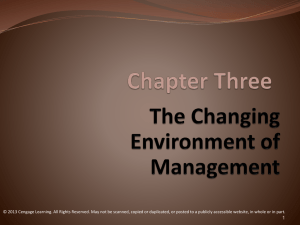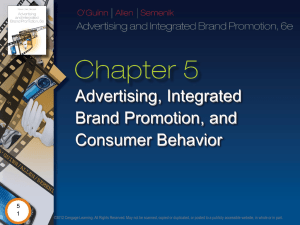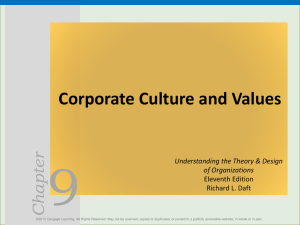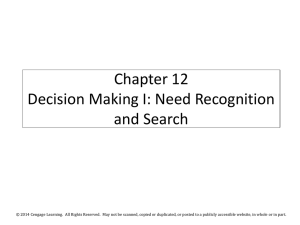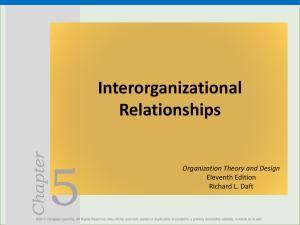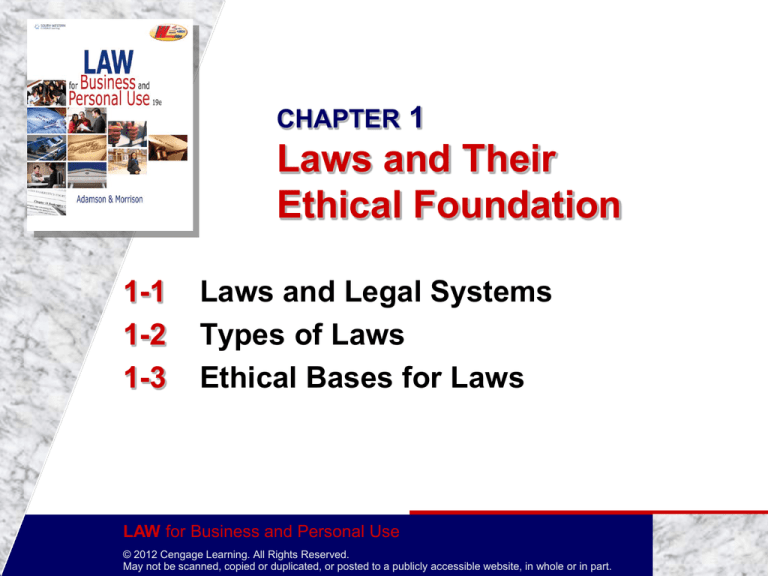
CHAPTER 1
Laws and Their
Ethical Foundation
1-1
1-2
1-3
Laws and Legal Systems
Types of Laws
Ethical Bases for Laws
LAW for Business and Personal Use
© 2012 Cengage Learning. All Rights Reserved.
May not be scanned, copied or duplicated, or posted to a publicly accessible website, in whole or in part.
1-1
Laws and Legal Systems
GOALS
Explain the stages in the growth of law
Describe the differences between common law
and positive law
Identify the origin of the U.S. legal system
LAW for Business and Personal Use
Chapter 1
© 2012 Cengage Learning. All Rights Reserved.
May not be scanned, copied or duplicated, or posted to a publicly accessible website, in whole or in part.
SLIDE 2
WHAT IS LAW?
Stages in the growth of law
1. Individuals are free to take revenge for wrongs
done to them.
2. A leader convinces revenge-minded individuals
to take money or goods instead.
3. Leader gives this power to a system of courts.
4. Leader acts to prevent and punish wrongs that
provoke revenge.
LAW for Business and Personal Use
Chapter 1
© 2012 Cengage Learning. All Rights Reserved.
May not be scanned, copied or duplicated, or posted to a publicly accessible website, in whole or in part.
SLIDE 3
WHAT IS LAW?
Common law versus positive law
Common Law: Law based on the current
standards or customs of the people.
Positive Law: Law based on the dictates of
central authority.
LAW for Business and Personal Use
Chapter 1
© 2012 Cengage Learning. All Rights Reserved.
May not be scanned, copied or duplicated, or posted to a publicly accessible website, in whole or in part.
SLIDE 4
CHECKPOINT
How does common law differ from positive
law?
Answer: Common Law is based on current
standards or customs among the people,
whereas positive law is dictated from above by a
central authority
LAW for Business and Personal Use
Chapter 1
© 2012 Cengage Learning. All Rights Reserved.
May not be scanned, copied or duplicated, or posted to a publicly accessible website, in whole or in part.
SLIDE 5
WHAT IS THE ORIGIN OF THE U.S.
LEGAL SYSTEM?
English common law
King’s Bench
Jury
An example
Advantages of English common law
Uniform while being able to adapt to changes in
society
LAW for Business and Personal Use
Chapter 1
© 2012 Cengage Learning. All Rights Reserved.
May not be scanned, copied or duplicated, or posted to a publicly accessible website, in whole or in part.
SLIDE 6
WHAT IS THE ORIGIN OF THE U.S.
LEGAL SYSTEM?
Equity: An alternative to common law
Equity: Basic fairness
Equity courts: citizens had no right to issue
injunctions or compel something to happen.
These court were given power by the king to
allow access to equitable remedies for citizens.
LAW for Business and Personal Use
Chapter 1
© 2012 Cengage Learning. All Rights Reserved.
May not be scanned, copied or duplicated, or posted to a publicly accessible website, in whole or in part.
SLIDE 7
CHECKPOINT
On which early legal system is the U.S. legal
system based?
English Common Law
LAW for Business and Personal Use
Chapter 1
© 2012 Cengage Learning. All Rights Reserved.
May not be scanned, copied or duplicated, or posted to a publicly accessible website, in whole or in part.
SLIDE 8
1-2
Types of Laws
GOALS
Identify the four sources of law
Discuss how conflicts between laws are resolved
Compare and contrast criminal and civil law, and
substantive and procedural law
LAW for Business and Personal Use
Chapter 1
© 2012 Cengage Learning. All Rights Reserved.
May not be scanned, copied or duplicated, or posted to a publicly accessible website, in whole or in part.
SLIDE 9
WHAT ARE THE SOURCES
OF LAW?
Constitutions: Document sets framework of
the government and its relationship to the
people.
Constitutional law: when courts interpret the
constitution.
Constitutions allocate powers:
1. Between people and their government
2. Between state governments and federal governments
3. Among branches of government
LAW for Business and Personal Use
Chapter 1
© 2012 Cengage Learning. All Rights Reserved.
May not be scanned, copied or duplicated, or posted to a publicly accessible website, in whole or in part.
SLIDE 10
WHAT ARE THE SOURCES
OF LAW?
Statutes: Law enacted by state of federal
legislatures
Congress was formed from the constitution
Congress is composed of elected officials that enact laws
called statutes.
Ordinances: Legislation enacted by a town, city, or
county board or commission
States give towns or cities the power to legislate matters.
When the town or city creates a new piece of legislation it is
referred to as an ordinance
Only effective within the boundary of the local government
LAW for Business and Personal Use
Chapter 1
© 2012 Cengage Learning. All Rights Reserved.
May not be scanned, copied or duplicated, or posted to a publicly accessible website, in whole or in part.
SLIDE 11
WHAT ARE THE SOURCES
OF LAW?
Case law: Made when an appellate court endorses a
rule to be used in deciding court cases
Occurs when a case is appealed to a higher court
The higher courts ruling becomes the new set of rules by
which all other cases are decided.
Stare Decisis: Doctrine that requires lower courts to follow
existing case in deciding similar cases.
Administrative law
Administrative agencies: governmental body formed to
carry out particular laws
Agencies are given power to apply law in specific cases.
LAW for Business and Personal Use
Chapter 1
© 2012 Cengage Learning. All Rights Reserved.
May not be scanned, copied or duplicated, or posted to a publicly accessible website, in whole or in part.
SLIDE 12
CHECKPOINT
What are the five sources of law?
Constitutions
Statutes
Ordinances
Case Law
Administrative Law
LAW for Business and Personal Use
Chapter 1
© 2012 Cengage Learning. All Rights Reserved.
May not be scanned, copied or duplicated, or posted to a publicly accessible website, in whole or in part.
SLIDE 13
WHAT HAPPENS WHEN LAWS
CONFLICT?
Constitutions and validity
Laws can be rules unconstitutional by courts
Supreme Court has the final say
Statutes and validity
Statutes can be looked at to see if the law
exceeds the scope of powers of the authoritative
body.
LAW for Business and Personal Use
Chapter 1
© 2012 Cengage Learning. All Rights Reserved.
May not be scanned, copied or duplicated, or posted to a publicly accessible website, in whole or in part.
SLIDE 14
CHECKPOINT
Which source of law in the United States is
the highest authority?
U.S. Constitution
LAW for Business and Personal Use
Chapter 1
© 2012 Cengage Learning. All Rights Reserved.
May not be scanned, copied or duplicated, or posted to a publicly accessible website, in whole or in part.
SLIDE 15
WHAT ARE THE MAIN
TYPES OF LAWS?
Civil and criminal laws
Civil Law: group of laws that allows individuals to
seek legal remedies for wrongs done to them.
Example: You forget to pay rent, the landlord has the
right to sue you.
Criminal Law: group of laws that defines and sets
punishments for offenses against society.
Example: Joe, a Doctor, intentionally harms his patients.
Joe can be convicted in a trial for wrongdoing.
You can be convicted of both a civil and criminal
law
LAW for Business and Personal Use
Chapter 1
© 2012 Cengage Learning. All Rights Reserved.
May not be scanned, copied or duplicated, or posted to a publicly accessible website, in whole or in part.
SLIDE 16
WHAT ARE THE MAIN
TYPES OF LAWS?
Procedural and substantive laws
Procedural Law: group of laws that define the methods for
enforcing legal rights and duties
Substantive Law: Defines rights and duties
Example: defines offenses such as murder
Business law
Laws that govern business situations and transactions
Usually concerned with contracts, property, and business
related areas.
Uniform Commercial Code (UCC): Widely adopted uniform
business law.
LAW for Business and Personal Use
Chapter 1
© 2012 Cengage Learning. All Rights Reserved.
May not be scanned, copied or duplicated, or posted to a publicly accessible website, in whole or in part.
SLIDE 17
TYPES OF LAW
Constitutional law
Based on constitutions
Statutory law
Enacted by legislative bodies
Administrative law Rules and regulations made by administrative agencies
Civil law
Addresses wrongs done to individuals
Criminal law
Addresses wrongs done to society
Procedural law
Deals with methods of enforcing legal rights and duties
Substantive law
Defines legal rights and duties
Business law
Rules that apply to business situations and
transactions
LAW for Business and Personal Use
Chapter 1
© 2012 Cengage Learning. All Rights Reserved.
May not be scanned, copied or duplicated, or posted to a publicly accessible website, in whole or in part.
SLIDE 18
1-3
Ethical Bases for Laws
GOALS
Define ethics
Compare and contrast consequences-based
ethics with rule-based ethics
Discuss ways in which ethics are reflected in laws
LAW for Business and Personal Use
Chapter 1
© 2012 Cengage Learning. All Rights Reserved.
May not be scanned, copied or duplicated, or posted to a publicly accessible website, in whole or in part.
SLIDE 19
ETHICS AND THE LAW
Ethics: A collection of standards of conduct
and moral judgment forming the basis of a
reasoned, impartial decision of what is right
and wrong.
Ethical Decisions are based on reason not
emotion
LAW for Business and Personal Use
Chapter 1
© 2012 Cengage Learning. All Rights Reserved.
May not be scanned, copied or duplicated, or posted to a publicly accessible website, in whole or in part.
SLIDE 20
ETHICS AND THE LAW
Basic forms of ethical reasoning
Consequences-based ethical reasoning: Moral
worth of a proposed action is based on the
consequences and alternatives to it.
Rule-based ethical reasoning: Acts are judged
based on the fundamental ethical rules set.
Wrong actions are never condoned even if they bring
about a good result.
LAW for Business and Personal Use
Chapter 1
© 2012 Cengage Learning. All Rights Reserved.
May not be scanned, copied or duplicated, or posted to a publicly accessible website, in whole or in part.
SLIDE 21
ETHICS AND THE LAW
Ethics reflected in laws
Representatives vote on laws that they feel will
be acceptable to the majority of the people they
represent.
Civil Disobedience: open, peaceful, violation of a
law to protest its alleged, or supposed, injustice.
Example: Dr. Martin Luther King Jr. engaged in civil
disobedience to protest the racial injustice.
He only believed that civil disobedience should be used
for very limited circumstances.
LAW for Business and Personal Use
Chapter 1
© 2012 Cengage Learning. All Rights Reserved.
May not be scanned, copied or duplicated, or posted to a publicly accessible website, in whole or in part.
SLIDE 22
CHECKPOINT
In the U.S. system of democracy, how are
ethics reflected in laws?
US democracy is based on the rules created by
our constitution. Ethical content is based on the
values of the people who elect legislators to make
these rules.
LAW for Business and Personal Use
Chapter 1
© 2012 Cengage Learning. All Rights Reserved.
May not be scanned, copied or duplicated, or posted to a publicly accessible website, in whole or in part.
SLIDE 23
PREVENT
LEGAL
DIFFICULTIES
As a citizen . . .
When moving to a new location, find out how the
laws in that county or city may affect you.
Before beginning a new business, consult an
attorney to learn about city, county, state, and
federal laws and how they may affect you.
Study business law so you can become an
informed citizen who is knowledgeable about
legal matters.
Continued on the next slide
LAW for Business and Personal Use
Chapter 1
© 2012 Cengage Learning. All Rights Reserved.
May not be scanned, copied or duplicated, or posted to a publicly accessible website, in whole or in part.
SLIDE 24
PREVENT
LEGAL
DIFFICULTIES
Recognize that fulfilling your duties as a citizen is
the greatest guarantee of your maintaining your
individual rights and liberties. These duties
include:
The duty to obey the law.
The duty to respect the rights of others.
The duty to inform yourself on political issues.
The duty to vote in elections.
The duty to serve on juries if called.
The duty to serve and defend your country.
The duty to assist agencies of law enforcement.
LAW for Business and Personal Use
Chapter 1
© 2012 Cengage Learning. All Rights Reserved.
May not be scanned, copied or duplicated, or posted to a publicly accessible website, in whole or in part.
SLIDE 25



